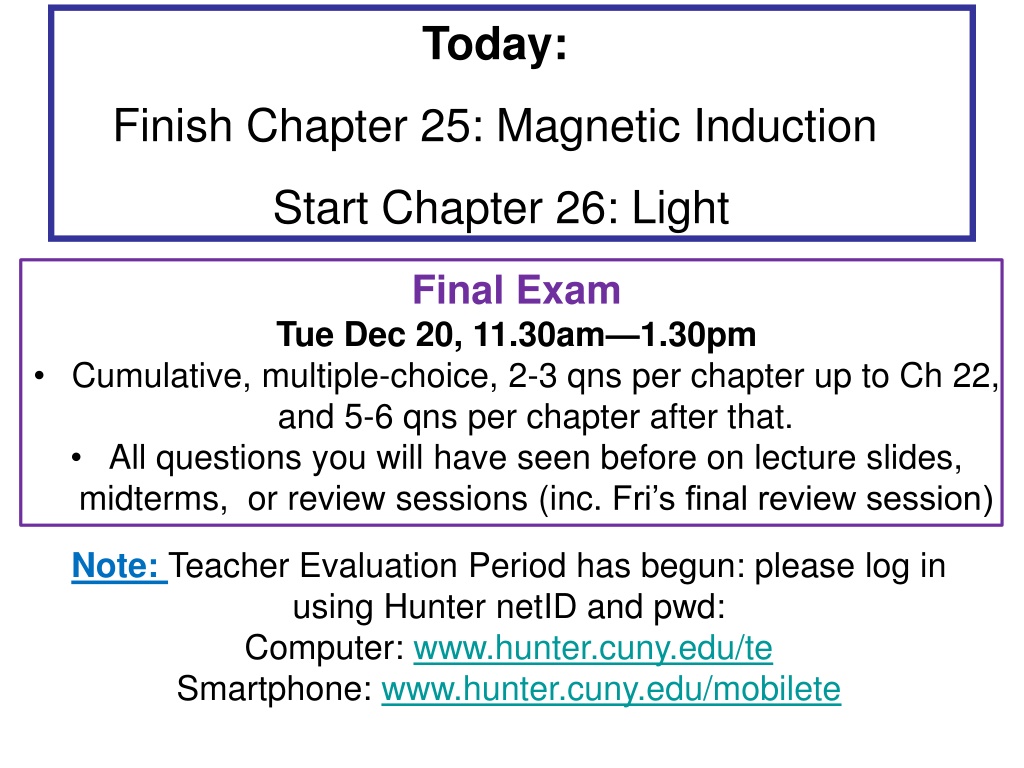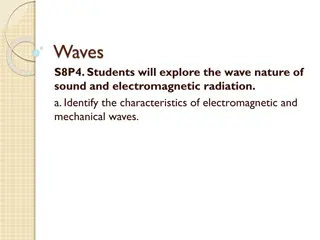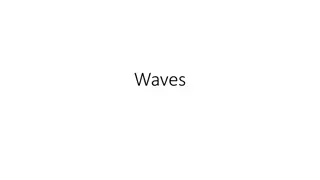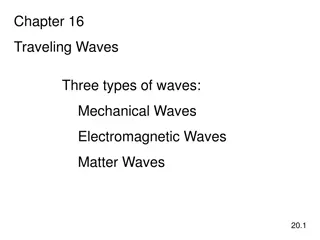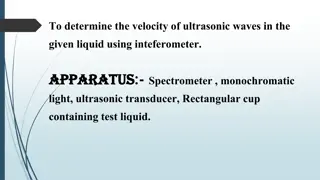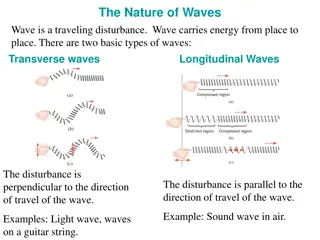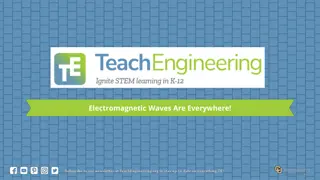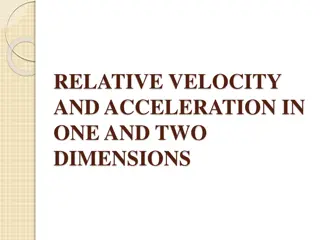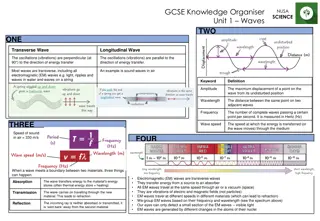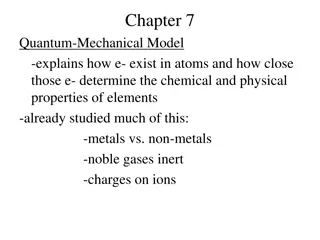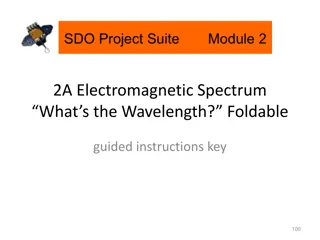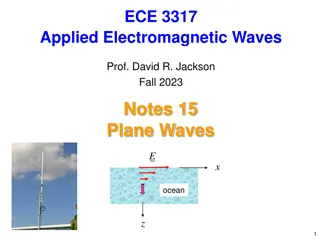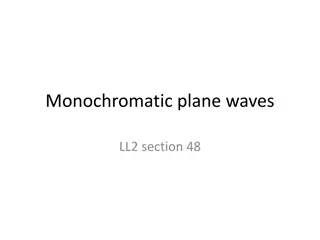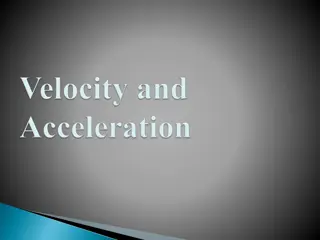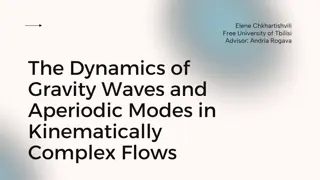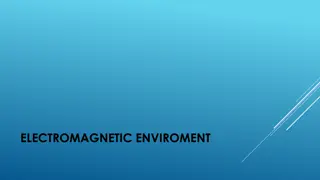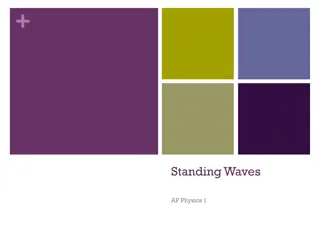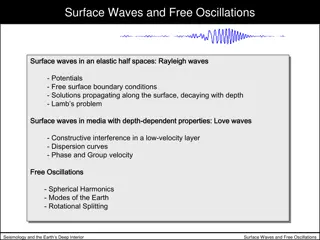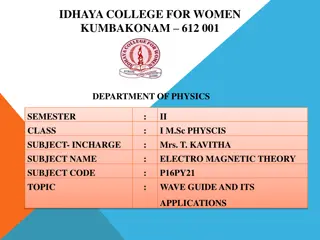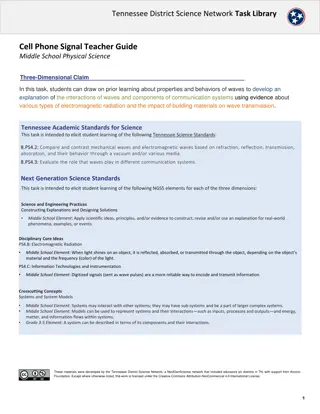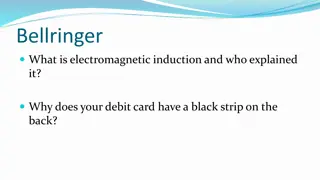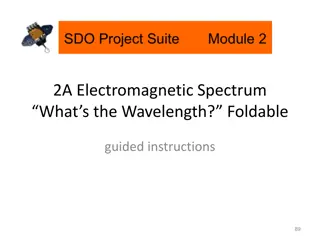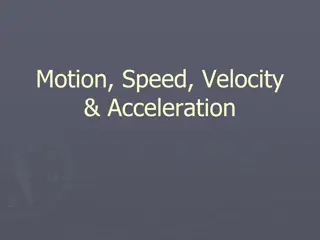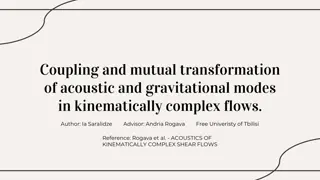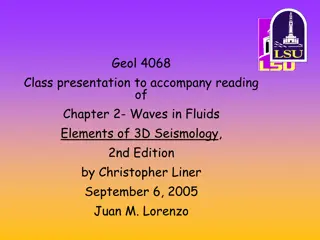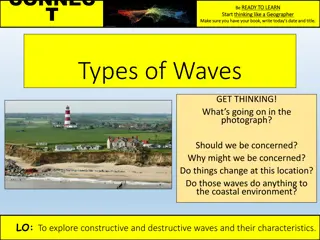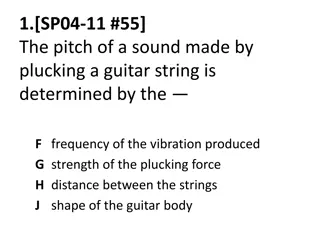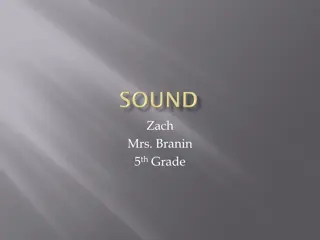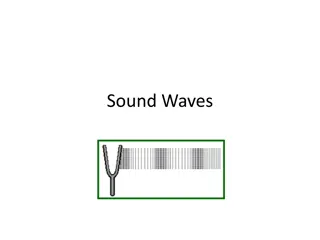Understanding Electromagnetic Waves and Their Velocity
Light, as a transverse wave, is a part of the electromagnetic spectrum produced by accelerating electrons. Electromagnetic waves originate from vibrating charges, creating a continuous cycle of electric and magnetic fields. The velocity of electromagnetic waves is constant due to energy conservation principles. Maxwell calculated this critical speed to be 300,000 km/s, which is the speed in vacuum and remains relatively consistent in different media.
Download Presentation

Please find below an Image/Link to download the presentation.
The content on the website is provided AS IS for your information and personal use only. It may not be sold, licensed, or shared on other websites without obtaining consent from the author. Download presentation by click this link. If you encounter any issues during the download, it is possible that the publisher has removed the file from their server.
E N D
Presentation Transcript
Today: Finish Chapter 25: Magnetic Induction Start Chapter 26: Light Final Exam Tue Dec 20, 11.30am 1.30pm Cumulative, multiple-choice, 2-3 qns per chapter up to Ch 22, and 5-6 qns per chapter after that. All questions you will have seen before on lecture slides, midterms, or review sessions (inc. Fri s final review session) Note: Teacher Evaluation Period has begun: please log in using Hunter netID and pwd: Computer: www.hunter.cuny.edu/te Smartphone: www.hunter.cuny.edu/mobilete
Light: preliminaries Light is the only thing we actually see e.g. When I see you, I am actually seeing light reflected off you. Light is a transverse wave (recall earlier), whose origin is accelerating electrons, e.g. in the sun Accelerating electrons not only can produce light, but also radio waves, microwaves, x-rays . Grouped together as electromagnetic waves. Different types of electromagnetic waves differ in their frequency (and wavelength): light is just a small part of the electromagnetic spectrum with certain frequency range
Electromagnetic Waves Origin is accelerating electron: how? Consider shaking a charged rod back and forth in space i.e. You create a current (= moving charges) that varies in time, i.e. a changing electric field in space and time. Recall from last chapter: a changing electric field creates a changing magnetic field, that in turn creates a changing electric field, that in turn i.e. a propagating disturbance The vibrating (oscillating) electric and magnetic fields regenerate each other - this is the electromagnetic (EM) wave.
Electromagnetic Waves cont. The EM wave moves outwards (emanates) from the vibrating charge.
Electromagnetic Wave Velocity An electromagnetic wave travels at one constant speed through space. Why? Inherently due to wave nature (e.g. objects like spacecrafts can change speed, and go at different constant speeds); specifically, induction and energy conservation: Recall (last chap): the strength of the induced fields depends on the rate of change of the field that created it. So, if light traveled slower, then its electric field would change slower, so would generate a weaker magnetic field, that in turn generates a weaker electric field, etc wave dies out. Similarly, if light sped up stronger fields,ever-increasing energy. Both cases violate energy conservation.
Electromagnetic Wave Velocity cont. Then what is the critical speed at which mutual induction sustains itself? Maxwell calculated this: 300 000 km/s = c i.e. 3 x 108 m/s This is the speed in vacuum, and about the same in air. Slower in different media (see later)
The Electromagnetic Spectrum In vacuum, all electromagnetic waves move at the same speed c, but differ in their frequency (and wavelength). recall speed c = f Visible light:4.3 x 1014 Hz to 7 x 1014 Hz i.e. red is at the low-freq end of light (next lowest is infrared) and long-wavelength violet is the high-freq end (next highest is ultraviolet) short wavelength
Clicker Question Which of the following is fundamentally different from the others? A) sound waves B) X-rays C) gamma rays D) light waves E) radio waves Answer: A The others are all electromagnetic waves: transverse oscillations of electric and magnetic fields.
Clicker Question Is it correct to say that in every case, without exception, any radio wave travels faster than any sound wave? 1. Yes 2. No
Answer: 1, until very recently*: Is it correct to say that in every case, without exception, any radio wave travels faster than any sound wave? Any radio wave travels at the speed of light. A radio wave is an electromagnetic wave, like a low-freq light wave. A sound wave, on the other hand, is fundamentally different. A sound wave is a mechanical disturbance propagated through a material medium by material particles that vibrate against one another. Sound is not part of the EM spectrum! In air, the speed of sound is about 340 m/s, about one millionth the speed of a radio wave. Sound travels faster in other media, and light is slower in other media, but, these factors are usually more like factor of 2 or 3, at most, not a million 1. Yes 2. No * In 1999, however, researchers in carefully controlled expts managed to slow light down to 17m/s!
The electromagnetic spectrum cont. Recall Ch 18 on waves: frequency of wave = freq of vibrating source. Applies to EM waves too, where source is oscillating electrons Note that EM waves are everywhere! Not just in air, but in interplanetary empty space - actually a dense sea of radiation. Vibrating electrons in sun put out EM waves of frequencies across the whole spectrum. Any body at any temperature other than absolute zero, have electrons that vibrate and (re-)emit in response to the EM radiation that permeates us, even if very low frequency.
Question A helium-neon laser emits light of wavelength 633 nanometers (nm). What frequency is this? What color ? Use c = f , so f = c/ = (3 x 108 m/s)/(633 x 10-9 m) = 4.74 x 1014 Hz i.e. red
Clicker Question Which of these lamps is emitting electromagnetic radiation? 1. Lamp A 2. Lamp B 3. Both 4. Neither
Which of these lamps is emitting electromagnetic radiation? 1. Lamp A 2. Lamp B 3. Both 4. Neither Answer: 3 All bodies with any temperature at all continually emit electromagnetic waves. The frequency of these waves varies with temperature. Lamp B is hot enough to emit visible light. Lamp A is cooler, and the radiation it emits is too low in frequency to be visible it emits infrared waves, which aren t seen with the eye. You emit waves as well. Even in a completely dark room your waves are there. Your friends may not be able to see you, but a rattlesnake can!
Transparent materials When light goes through matter, electrons in the matter are forced to vibrate along with the light. Recall Ch 20 on sound response of material depends on how close the forced vibration is to the natural frequency of the material. Same is true here with light. First note that visible light has very high freq (~1014 Hz), so if charged object is to respond to this freq, it has to have very little inertia i.e. mass. An electron does have tiny mass! Transparent materials allow light to pass in straight lines
Transparent materials Simple model of atom: think of electrons attached to nucleus with springs. Light makes these springs oscillate. Different atoms/molecules have different spring strengths - so different natural frequencies. If this natural freq = that of impinging light, resonance occurs (recall ch 20) i.e. vibrations of electrons build up to high amplitudes, electrons hold on to the energy for long times, while passing it to other atoms via collisions, finally transferred to heat. Nottransparent, i.e opaque So materials that are opaque to visible light, have natural frequencies in the range of visible light.
Transparent materials cont. Glass is transparent: its natural freqs are higher, in the ultraviolet range. So glass is not transparent to ultraviolet. But is transparent to lower freqs i.e. visible spectrum. What happens in this off-resonance case? Atoms are forced into vibration but at less amplitude, so don t hold on to the energy long enough to transfer much to other atoms through collisions. Less is transferred to heat; instead vibrating electrons re-emit it as light at same frequency of the impinging light. (see more next slides) Infrared waves frequencies lower than visible can force vibrations of atoms/molecules as well as electrons in glass. Increases internal energy and temperature of glass. Often called heat waves.
Clicker Question Given that electrons in the atoms in glass have natural frequencies in the ultraviolet (UV), and that the atoms/molecules in glass have natural frequencies in the infrared(IR), which of the following is true? A) B) C) D) E) Glass is transparent to UV and IR, but not to visible Glass is transparent to UV, but not to visible or IR Glass is transparent to IR and visible, but not to UV Glass is transparent to visible, but not to UV or IR None of the above is true Answer: D
Transparent materials cont. So: Light-transparent materials (like glass) have natural frequencies that don t coincide with those of light. The atoms re- emit after absorbing. This re-emission is time-delayed: This leads to speed of light being different in different media: In vacuum, it s c When light emerges back into air, it travels again at original c In air, only slightly less than c In water, it s 0.75c In glass, 0.67c (but depends on type of glass)
Questions (1) Why in the sunlight is a black tar road hotter to the touch than a pane of window glass? energy in the road surface, but transmitted through the glass to somewhere else. Sunlight is absorbed and turned to internal (2) Can you get sunburned through a glass window? transmit it, so you won t get sunburned (although you might get hot! as light in the visible-range is transmitted and then you absorb it). Glass is opaque to ultraviolet light, so won t
Opaque materials Have natural frequencies in the visible range, E.g. books, you, tables, metals So, they absorb light without re-emitting it. Light energy goes into random kinetic energy, i.e. heat. Usually, not all the frequencies in the visible light spectrum are resonant - those that aren t, get reflected: this gives the object color (see much more next chapter)
Some cases of interest: Earth s atmosphere transparent to some UV, all visible, some infrared. But is (thankfully) opaque to high UV. - the small amount of UV that does get through causes dangerous sunburn. - clouds are semi-transparent to UV, so can still get sunburned on a cloudy day. Water transparent in the visible. - This explains why objects look darker when wet: Light is absorbed and re-emitted, bouncing around inside wet region; each bounce loses some energy to material. So less light enters your eye looks darker.
Shadows A thin beam of light is called a ray. Shadow = region where light rays cannot reach e.g. caused by an obstacle in the path of the light. Sharp shadows are from large far-away light source, or from a small nearby one. Blurry shadows from large nearby source. If too big, no shadow. E.g. Move a pen from near a light bulb to further away shadow on wall gets sharper.
Shadows cont. Question: Why is there no definite shadow of your hand when you hold it high above your desk? Because of the many different light sources in the room - the shadow cast by one source is illuminated by another light source. Umbra = total shadow; penumbra = partial shadow how do we get penumbras? e.g. where some of the light is blocked and light from another source fills it in. Or when light from a large source is only partly blocked.
Shadows of the earth and moon Both earth and moon cast shadows when sunlight incident When one passes into the shadow of the other eclipse: lunar eclipse Demonstrates umbra vs penumbra: Sun is so big that some parts of earth are in the umbra - see complete darkness - whereas others are in penumbra see partial eclipse (crescent) solar eclipse
Questions (1) Why do you not cast a shadow on the ground on an overcast day? A relatively small light and distant source such as the sun casts a relatively sharp shadow. On an overcast day, the primary sun is blocked and the whole sky (the secondary light source), illuminates you. The source is now so big that no shadow is seen. (2) Lunar eclipses are always eclipses of a full moon. i.e moon is full just before and after the earth s shadow passes over it. Why? Can we have a lunar eclipse when we have a half-moon? Lunar eclipse is perfect alignment of Sun-Earth-Moon. Not-quite- perfect alignment gives Earth observers a full view of the moon since the sunny-side of the moon is facing the night-side of the Earth. We cannot have a half-moon eclipse, since at halfmoon, the lines from Earth to moon and from Earth to sun are at right angles, so shadow of the Earth does not fall on the moon.
Clicker Question While Earth is experiencing a total solar eclipse, an observer on the moon on the side that faces the Earth would see A) Earth disappear from the sky. B) Earth dim and turn reddish. C) nothing unusual. D) a tiny dark spot move across the face of Earth. Answer: D Solar eclipse is when the moon is between the sun and earth, all in a line. To a viewer on the earth, the moon blocks the sun. A viewer on the moon facing the earth, sees the moon s shadow on the earth a tiny dark spot.
The Eye is what we detect light with: Lens does most of the bending to focus images onto the retina. Cornea -transparent cover, through which light enters and bends to enter pupil Retina is very sensitive to light, made of antennae called rods and cones (see next slide). Not uniform. Fovea is most concentrated so images most distinct here. Pupil Blind spot no rods and cones - optic nerve exits here. Try the fun expt (26.15) in your book !! Image disappears if focused on blind spot. (aperture in iris)
More on the eye Rods - mostly towards periphery of retina - sensitive to light or dark but not color. Cones - 3 types, depending on whether they detect high- freq, intermediate-freq, or low-freq. - denser towards the fovea, and most dense there. - detect color - need more energy than rods before they fire an impulse So, cones don t detect low intensities, e.g. at night, it's your rods that do the seeing. If want to see detail and color of object, focus it on the fovea. In contrast, at periphery of vision, can t tell what color objects are ( next slide)
More on the eye Eg. DEMO for homework! Get a friend to jiggle colored objects at side, where you can only just see them you see them moving, but can t tell what color they are! Periphery of eye is very sensitive to motion makes sense from evolutionary point of view.
Theres some more about the eye in your book, that makes for interesting reading, but won t be covered or examinable in this course. E.g. How pupil dilates when we are sense something that pleases us, and contracts if we find something repugnant! E.g. Lateral Inhibition effect which tends to make us notice boundaries . E.g. Optical illusions consider the illusions in Fig. 26.21 in your book!
Clicker Question Given that cones don t work at low intensity, why do stars always look white to us, even though time-exposure with camera shows them to be brightly colored (red for cooler stars, blue for hotter)? A)Because the color only arises through interaction with the camera actually starlight is white B) Because starlight too weak to trigger the cones in our retina C) Because starlight is too weak to trigger the rods D) None of the above Answer: B Cones have a higher threshold intensity before they fire, c.f. rods. So we see the stars with our rods which cannot detect color; hence perceived as white.
